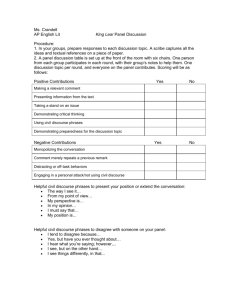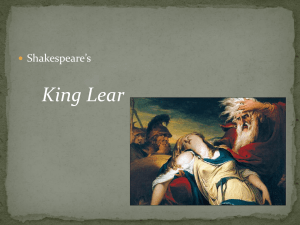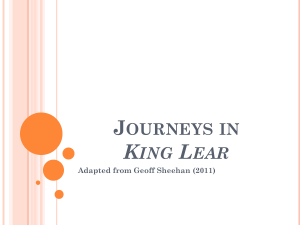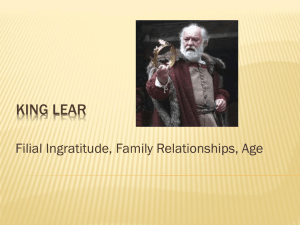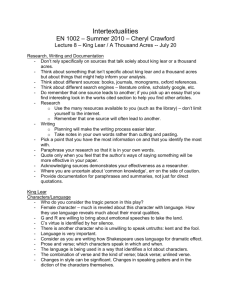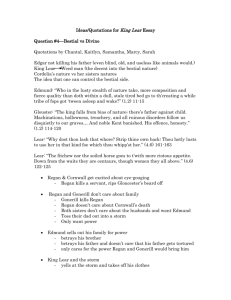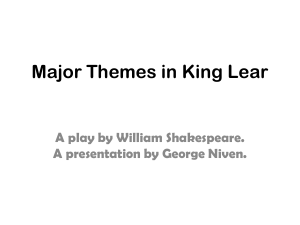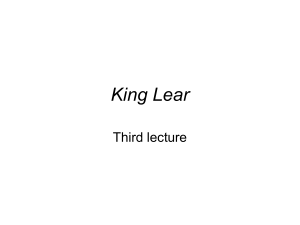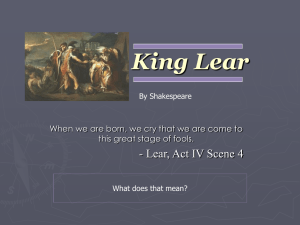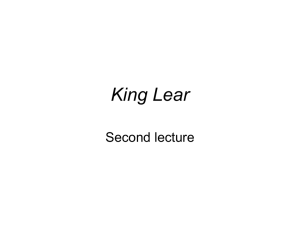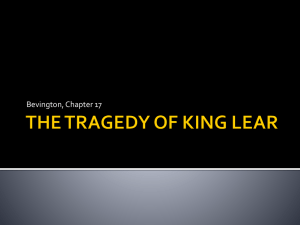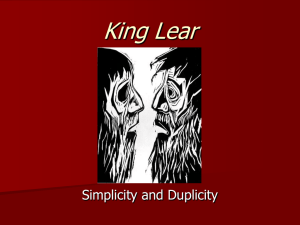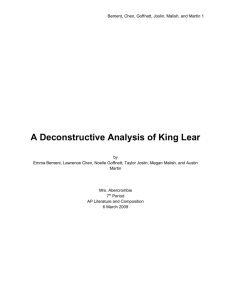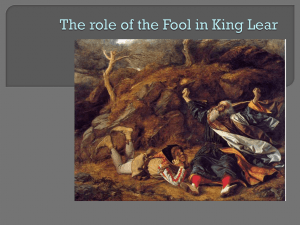Fourth King Lear Lecture
advertisement
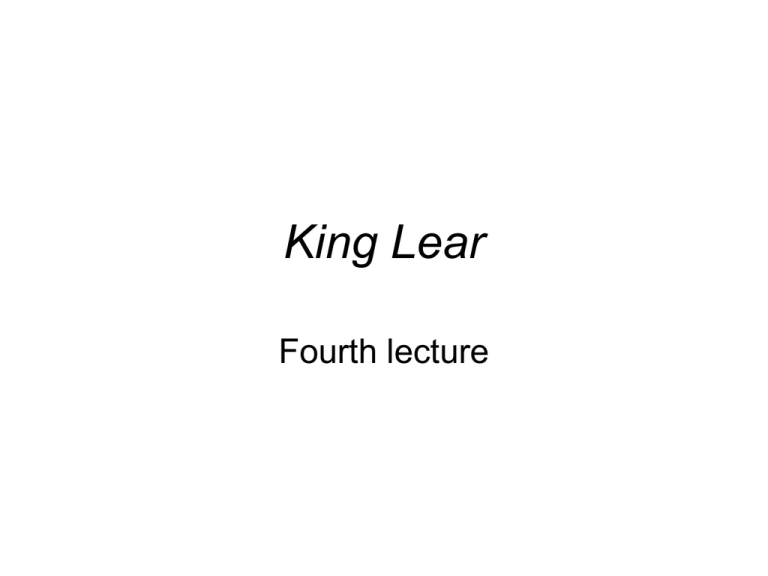
King Lear Fourth lecture Endings • Strange to say, King Lear hasn’t always ended with the almost unbearable ending Shakespeare assigned it. • In the late 17th cent. Nahum Tate, a poet and theater director, produced a version of the play that ended happily, with a romancelike conclusion. • He cut the King of France from the first scene, and instead suggested a potential love between Cordelia and . . . • Edgar! • And at the end of his text of the play (extensively revised throughout), he had Lear save Cordelia from hanging. • Edgar and Albany enter and in turn save Lear. • Lear is returned to his kingship. • Cordelia becomes queen and agrees to marry Edgar. • Gloucester survives, and he, Kent, and Lear retire together, while Cordelia and Edgar take over the kingdom. • Obviously Tate had to write a new final scene. • Fool is also cut. • And this is the version of King Lear that played throughout the 18th century. Nahum Tate’s ending • Tate’s ending seems a travesty to us. • (Of course we also need to acknowledge what we do the text of Shakespeare’s plays – the cuts and rewriting of contemporary productions – and wonder how those will look a century or two hence.) • But does the trajectory of the plot demand tragedy? • Samuel Johnson (“Dr. Johnson”), who was used to the Tate version on stage, said he could never bear to read Shakespeare’s actual ending until he had to edit the play. • Lear’s “journey” from a foolish decision, rejection, madness, insight in madness, recovery and finally his return to Cordelia might seem a narrative pattern that could lead to a romance ending. • From a purely narrative point of view, Tate’s ending may not seem entirely inappropriate. The meeting with Cordelia • There was a climactic scene in the old morality plays when the penitent protagonist was given a “garment of repentance” by the saving Virtue character. • IV.7: Lear brought in, freshly clothed, asleep in chair. • Cordelia slowly wakens him with music, kisses him. • Lear’s “true” delusion: “Thou art a soul in bliss . . .” • And in kneeling plays the part in old the morality play. • And slowly recovers a sense of himself. • But only in a relational sense to Cordelia? “as I am a man, I think this lady/ To be my child Cordelia.” • His guilt? “No cause. No cause.” • And then in V.3 he imagines a contented life in prison with Cordelia. • The meeting and penitence would be the denoument of the morality play. “Justice” in the Gloucester plot • Edgar’s “miracle” scene analogous to Cordelia’s meeting with her father. • But despair is cured abstractly, by the staged “miracle”? • “Bear free and patient thoughts.” • Reiterated at V.2: 9-11: “Ripeness is all.” (Cf. Hamlet’s “the readiness is all.”) • But still Edgar doesn’t reveal himself. • After the battle, Edgar and Edmund “exchange charity.” • And Edgar holds to a sense of absolute justice: “The dark and vicious place where thee he got/ Cost him his eyes.” • But seems to admit his own fault in concealing himself from his father: ll 193ff. • The circumstances suggest a dark and rigid justice playing itself out: Edmund and Gloucester both die. • And Edgar, the just son, survives. • But how does it compare to the Lear story? Irrelevance of justice in the Lear plot? • By contrast, everything seems excessive in Lear story. • Lear’s anger at Cordelia, his utter rejection by older daughters, his suffering. • And clearly “justice” seems irrelevant. • The loss of Lear’s kingdom to the evil forces. • And finally the terrible stage direction: “Enter Lear with Cordelia in his arms.” • The play gives us no hint that this will happen. • And no “poetic justice” in the death of the one “redeeming” daughter: • A nameless gentleman had said of Cordelia: “Thou hast one daughter/ Who redeems nature from the general curse/ Which twain have brought her to” (IV.6.204-06). • If death had indeed been implicit in the first scene, it was not for this death. “Enter Lear . . .” • Lear enters with one long sustained cry of anguish: the text’s “howl, howl, howl!” are more a stage direction, I suggest. • “O, you are men of stones” is as much directed to the audience as to those on stage. • And Lear’s words tell the audience what they need to know about the actor’s body he carries on stage. • Kent’s, Edgar’s, and Albany’s words speak also for the audience: is this an image of the terror of the Last Judgment? • Lear’s words and actions try to verify Cordelia’s death: “She’s gone forever.” • Or is she, “What is’t thou say’st?” • But the feather apparently doesn’t stir. • Can we imagine a more heart-breaking scene on the stage – or a more sustained stage meditation on the fact of death? “All’s cheerless, dark, and deadly” • • • • • • • • • • • Kent’s despairing words. Lear attends only to the dead Cordelia. At l. 311 Albany cries out “O, see,see!” What are we to see? What does the actor playing Lear do? Lear’s lines heart-breakingly focus on the lifelessness of Cordelia and the finality of death. So if death was implicit in the opening scene, we get an uncompromising vision of it. The gesture of the help with the button: where have we seen this before? And finally Lear’s insistence that we see Cordelia’s lips. Does he think they’re moving, that she’s saying something? Clearly he’s deluded. Or does he see something we can’t see? Stage – and audience -- reaction • Kent encourage’s Lear’s death: for him the world is a “rack,” an instrument of torture. • And Kent seems to envisage his own death: “I have a journey shortly to go . . .” • Edgar’s final formulation: what we feel, not the usual comforting words. • Gloucester’s earlier words about the world: “I see it feelingly.” • He meant the need for touch in his blindness, but the word has resonance. • Will Edgar ever be the same after these experiences? • Will the audience?

